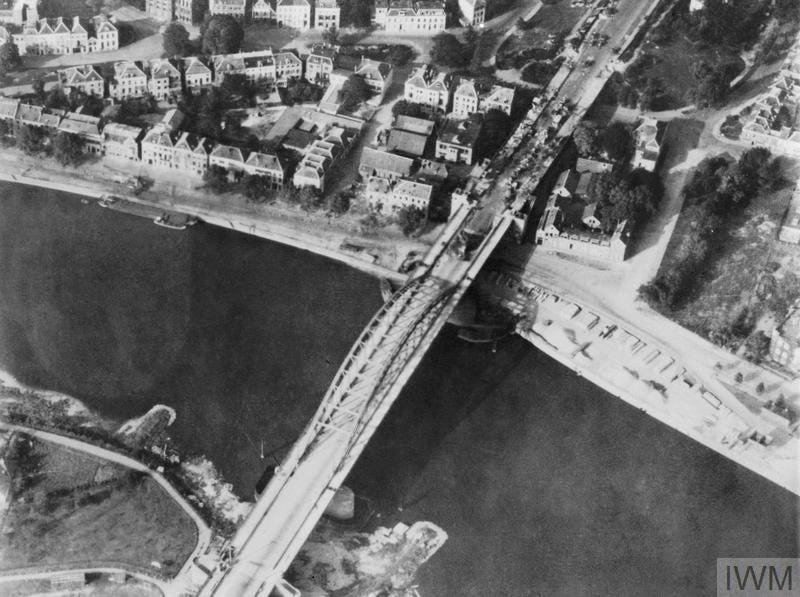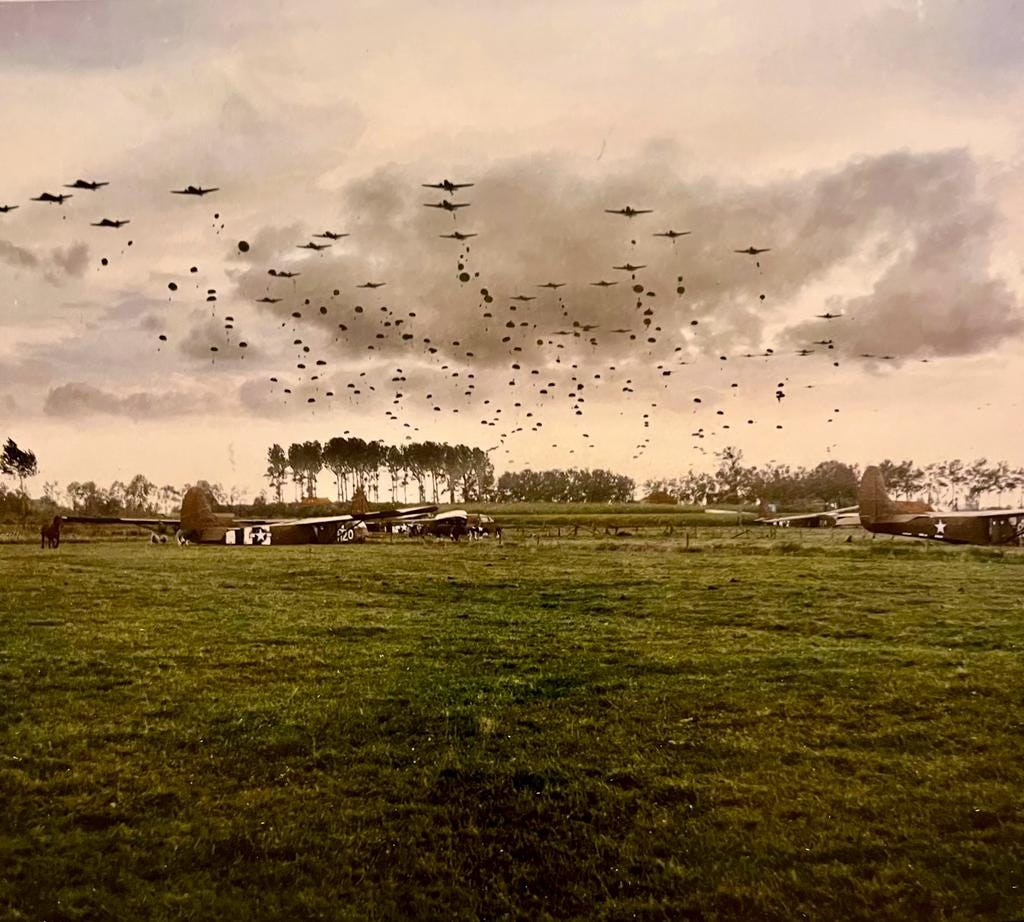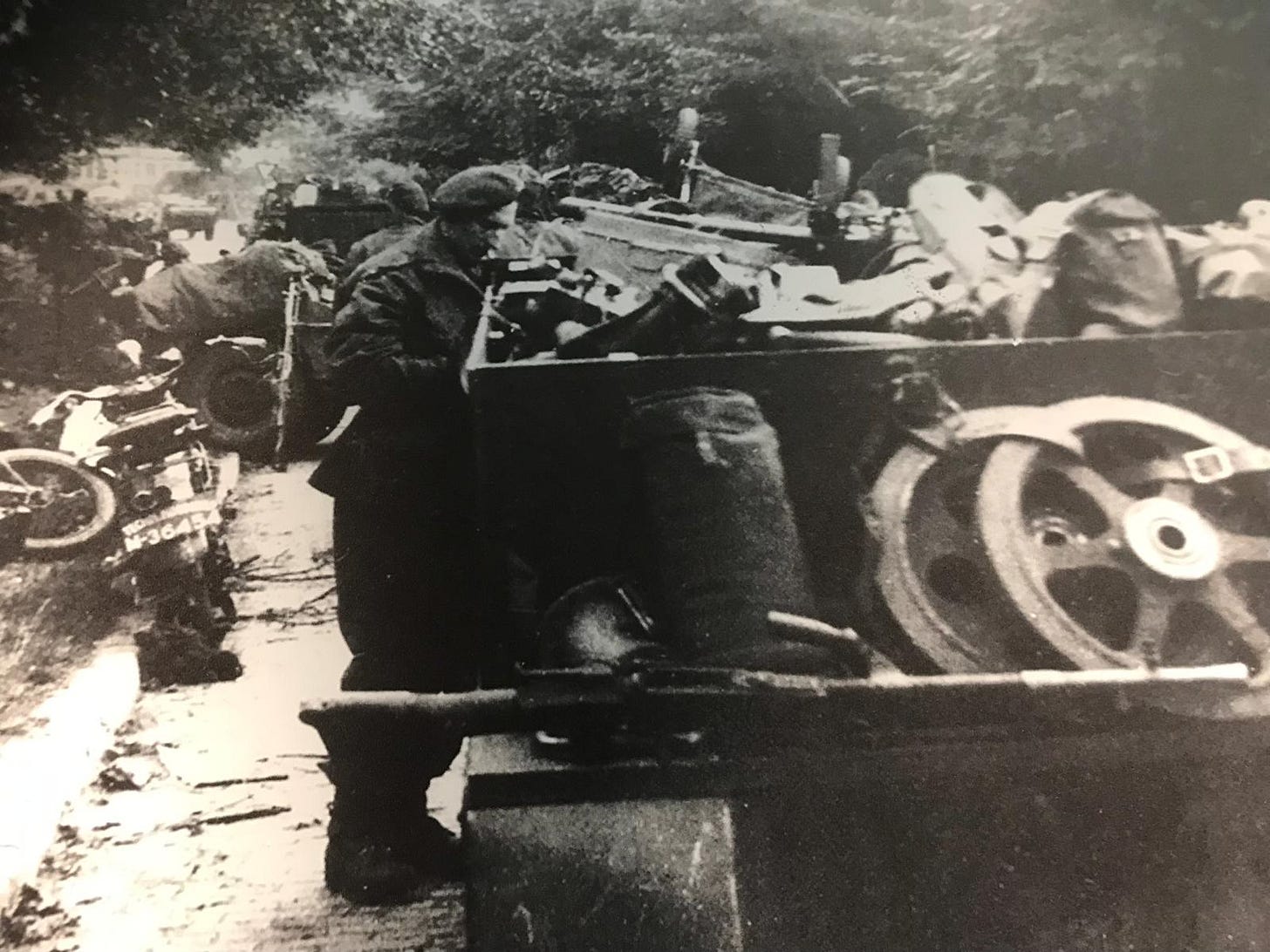It was Joseph Campbell who said,
It is by going down into the abyss that we recover the treasures of life. Where you stumble, there lies your treasure.
And, God damn it, he was right.
Life can be really hard, so we may as well find purpose in the pain.
In the autumn of 2019, a year after my divorce, I found myself in an emotional wilderness, adrift and seeking meaning in a life I barely recognised.
The end of my marriage was, without question, for the best. Yet internally, I remained torn, caught between relief and a yearning for clarity that felt beyond reach.
Some grounding force was needed to make sense of this turmoil, and I could think of no better guide than my step-grandfather, Cyril, the man who’d when I was a boy, had treated me with kindness and patience that seemed boundless.
Cyril, an amateur football coach and self-employed window cleaner, had fought with the British Airborne during WWII. Although he wasn’t obliged to take an interest in my well-being, he did so without fail.
This man, who leapt out of a Douglas C-47 Dakota into one of the war’s fiercest battles, had never hesitated to answer my questions about his experiences. His honesty and humour softened his memories of war, making the history feel vivid and strangely accessible.
To better understand the resilience I needed, I decided to retrace Cyril’s path at Arnhem, hoping his strength might guide me through my own tribulations. Not wanting to travel alone, I invited my two half-brothers.
Though we’d spent maybe 40 days together in as many years, this trip offered us a chance to reconnect - not only with our family’s story but with each other.
The Journey Begins: Riding into History
From the moment we crossed the Channel, racing through France and Belgium and into the Netherlands, we were immersed in Cyril’s legacy.
After a gruelling eight hour ride, with sore bodies we arrived at the outskirts of Wolfheze, the landing zone where he and countless others descended into the fray.
As I stood on that quiet heath, picturing the man who had once leapt from the skies, I felt closer to him than ever. Cyril often joked about joining the paratroopers because “they got paid more,” and if he was to be shot, he might as well be well-compensated. His lightheartedness belied a toughness that resonated deeply.
At almost every building, we saw Pegasus flags flying, symbols of the British 1st Airborne Division. The respect of the Dutch for these liberators ran deeper than I could have imagined, embodied by communities still honouring men like Cyril, tending graves and sharing stories across generations.
That evening, our host at a small Airbnb in Wolfheze greeted us with a bottle of home-brewed beer and, amusingly, a small bag of weed. (Don’t worry, like several US presidents before me, I didn’t inhale).
The gesture, though casual, lifted the mood. Yet, as we drank in the woodlands, the shadow of why we were here - to follow Cyril’s journey - anchored us.
Sometimes, it’s all too easy to lose sight of the bigger picture, getting caught up in our own pain and forgetting there's more beyond the immediate suffering. That’s where I found myself - trapped in a cycle of self-pity, disconnected from any narrative larger than my own.
Oosterbeek and a Glimpse into the Past: The Airborne Museum
After an uncomfortable night, we climbed back onto the bikes and drove to the Airborne Museum in Oosterbeek. Walking through the displays of uniforms, letters, and photographs, the weight of history pressed upon us. And then, there he was - our grandfather, unmistakably captured in a black-and-white photo, leaning against a Bren Gun Carrier, his gaze fixed on the unseen.
Seeing his face transported me back to those boyhood days when I peppered him with questions about the war.
I remembered asking, in my childish curiosity, if he had ever killed anyone. “Well,” he replied with his usual dry humour, “I shot a lot of bullets, be embarrassing to think I missed with all of them.”
The levity in his response revealed his deep humility, deflecting the horrors he had witnessed with a smile that, somehow, softened the past.
A Bridge Too Far: The Gravity of John Frost Bridge
From Oosterbeek, we rode to John Frost Bridge, where British paratroopers fought desperately to hold their ground.
Standing there, the scale of the bridge and the intensity of the battle became starkly real. The structure seemed to loom over us, its silent arches bearing witness to the fierce struggle that had unfolded there in 1944.
Here was the site of the “bridge too far,” where Montgomery’s ambition had met the brutal limits of reality, and the cost was paid in the lives and blood of thousands of men like my grandfather.

Queen Elizabeth Hospital: Echoes of Pain and Resilience
Our final stop was the Queen Elizabeth Hospital, where Cyril was taken after being wounded in battle. Now a set of modern apartments, the building still bore its original facade. I imagined the chaos of the wartime hospital, the frenzied work of medics, and Cyril’s own journey from here to capture and eventual imprisonment.
Cyril’s tales of his P.O.W. experience - of multiple escape attempts and harsh conditions - had always amazed me. He spoke of those dark days with a strange levity, his humour as strong as his resolve. I saw now that his survival, both physical and emotional, had demanded a resilience I was only just beginning to grasp.
An Extract From Grandfather’s Post-Combat Report
Here, written in our grandfather’s own words as a 22-year-old, is an extract from his post-combat report, dated 15 November 1945, just after his return to the UK:
"I was taken prisoner at Arnhem on the 5th October 1944 from the St Elizabeth’s hospital where I was taken after being wounded. From the hospital we were taken to the town of Appeldoorn in N.E. Holland to a Red Cross P.O.W. hospital where we stayed one night. From there we were taken to the railway sidings at the far end of the town and put in box cars.
We moved off from the railway sidings at approximately 19:30hrs, by then it was almost sunset, so I decided that this was the best time for an escape. I knew approximately where I was as we had only been an hour coming from Arnhem. I waited until the train was climbing a hill at about 15 to 20 mph and then climbed out of the small window on the far side of the box car. I swung out onto a hand-rail and from there to the bumpers of the cars.
The guards were placed in every other box car, there not being one in my own box car. I thought I had pretty good chances of making the bumpers, which I did. I dropped in between the two cars and waited until the train and cars passed over me then proceeded in the direction of Arnhem hoping to meet up with some of our forward troops.
I travelled across country for 5 days without seeing anyone but German patrols, I then realised I must be some way out of my course. I had no map or compass so I decided to try a Dutch farm house to get my bearings, they told me I was at a small village called St Edé some 40 miles from Arnhem and told me the Germans were only ten minutes from the village, rather than endanger the people I decided to move on.
After travelling a further two days I came to a forest which took me 3 days to get through, whilst travelling through this forest I had no food whatsoever so I decided to stop at the next farm house and try and get some food from the people. On arriving at the next farm house I found that it had been evacuated by the tenants so I pushed on to the next village where I obtained food from the schoolmaster of the village.
He told me the nearest way to Arnhem, so I travelled by night until I came to some barbed wire fences. I crossed these and found a small hut about 5 miles from the previous village. I stayed there two and a half days and was sleeping in the hut when I was aroused by a Luftwaffe Patrol.
They took me to the H.Q. of the local Luftwaffe. I was put in confined cells until being transported to a town on the borders of Holland and Germany. There I was put into a guarded warehouse for three days.
I decided to try and escape from this building. I forced a fanlight protruding inside the warehouse and found a fire escape leading down to the ground. On reaching the ground floor of the warehouse I found the barbed wire too high and wide to cross.
I was taken back into the warehouse and transported to Dulag Luft in the Rhine Valley."
Closing Reflections: Honouring the Legacy of Resilience
Reading my grandfather’s words, unfiltered and raw, gave us all pause. His stark account of escape attempts, capture, and survival painted a picture more vivid than any retelling could. Here, preserved in ink, was a testament to his resilience - a quiet but enduring statement that even under the harshest conditions, the human spirit has a way of holding firm.
This journey wasn’t just about tracing the steps of a man we deeply admired. Standing on the fields where he once fought, where others fought alongside him, felt like stepping into a history that lived on, its echoes as strong as the day they sounded. This history was a reminder: resilience is not only for those we deem heroic, but also for those seeking purpose in a world that too often feels chaotic and fragile.
The Dutch people’s unwavering respect for the men who fought to liberate them is a testament to a shared resilience -of both the liberators and the liberated. Walking through the towns still flying the Pegasus flag, watching schoolchildren tend the Commonwealth graves, the reverence was palpable. We were humbled, reminded of the profound courage that defined our grandfather’s life.
At this point, I thought we’d experienced the trip’s emotional peaks…
I was wrong…
For years, I’d wanted to visit Auschwitz - a journey inspired by reading Edith Eger’s The Choice, which opened my eyes to resilience in the face of unspeakable hardship.
So, after Oosterbeek, we set out again, heading south to Eindhoven, where a flight to Kraków awaited.
What lay ahead would test our understanding of resilience in ways we could not have anticipated.
Read more in Part Two, where we confront history’s darkest chapter and discover new lessons in endurance and the human spirit.
Looking Forward
Life is rarely straightforward, and when it’s hardest, we’re often tempted to turn away from our pain. But it’s in those dark places that meaning takes root - if we choose to look.
If you’re feeling lost or disconnected - from family, history, or even yourself - sometimes the best way forward is to look back. To find grounding in the stories that anchor us to something larger than our immediate struggles. This journey to Arnhem was my attempt to understand my grandfather, but I returned with something more profound: a renewed sense of purpose, connection, and resilience.
Maybe you’re standing at a similar crossroads, searching for that anchor. Perhaps you, too, are looking for something to hold you steady when the world feels unstable.
My journey may not be a blueprint, but it shows that meaning often lies in confronting the past head-on. In seeking out the stories that shape us, we don’t just find answers; we find new paths forward.
If you’re ready to rediscover your own resilience, begin by reconnecting - with your past, your family, and most importantly, with yourself.
Connect With Me
Subscribe to Life’s Lessons Unpacked for insights into building resilience, reconnecting with your history, and thriving through life's most difficult moments.”
If this story resonated with you or if you have reflections on family history, resilience, or life’s unexpected journeys, I’d love to hear from you. Drop a comment or as ever, leave a ❤️ or reach out directly - I’m always open to connecting with readers interested in growth, history, and understanding the complexity of life.
By subscribing, you’ll receive:
Practical strategies for developing emotional resilience and reconnecting with yourself.
Real-life stories and reflections on navigating relationships, parenthood, and personal growth.
Insights drawn from 20 years of coaching experience, designed to help you thrive during life’s most challenging times.







Brilliant Mark, fascinating stuff , and your grandfather, WOW !!!! All those escape attempts, so very brave. What an amazing journey for you and your brothers to retrace his journey
Fascinating !